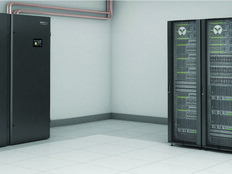The Thoroughly Modular Data Center
Breaking Mod
Modular and mobile data centers offer some significant benefits, but agencies should be aware that they can have drawbacks as well. These include:
1. Not instant IT.
Though it’s faster than building a traditional data center, setting up a modular or mobile data center can still take months to prepare a site and get sufficient power and bandwidth in place, notes Anna Maria Bailey, program manager for Lawrence Livermore National Laboratory’s high-performance computing facility.
2. One size fits all.
Prefab units tend to come with a single image across every server, making them harder to customize — though some agencies see that as a plus.
3. They can’t do everything.
Modular data centers can’t always scale up to fit every job. For example, the modular data center at Lawrence Livermore has sufficient server density to do Big Data analytics, but not enough to conduct high-performance data simulations.
Many federal data centers are hulking warehouses crammed with servers on racks, backup power, cooling units and massive lines of electrical wiring and networking cable.
But some agencies, such as Lawrence Livermore National Laboratory and the Veterans Affairs Department, are taking a closer look at modular data centers — “pods” or “cubes” built by a single manufacturer that come stocked with servers, racks, power and cooling — to respond to a variety of computing challenges. Some of them are even on wheels.
Recognizing the benefits of going modular, numerous manufacturers have begun offering such products, including the Cisco Containerized Data Center, HP’s Flexible Data Center and IBM’s Portable Modular Data Center.
The advantages to going modular are speed and cost, says Anna Maria Bailey, program manager for Lawrence Livermore’s high-performance computing (HPC) facility. It takes about half the time to prepare a site for a pod than for a traditional data center, she says.
The national security design lab has had a modular data center on its Livermore campus since 2010, she says. But the lab is also taking the same modular approach to new data center construction for HPC. Instead of outfitting an entire 48,000-square-foot data center warehouse with power and cooling, the lab may build out 6,000 square feet at a time. As computing needs and technologies change, this allows Lawrence Livermore to prep additional square footage without having to rip and replace what it had installed before, Bailey explains.
“We want to get out of doing construction over and over, and just build what we need when we need it,” she says. “So as the HPC technology changes, we can adapt. Our highest density racks draw 100 kilowatts of power, but we’re already looking at 200kW racks, and in a few years they might pull 500kW each. Today’s HPC racks are cooled by a mixture of liquid and air, but tomorrow’s may be all liquid cooled. Going modular gives us a type of flexibility we didn’t have before.”
The Mod Squad
Three major reasons for going modular involve scalability, lowered costs and simpler management, notes Kelly Quinn, research manager with IDC’s Datacenter Trends and Strategies Group.
“Modular allows you to scale out your data center as needed and to control costs,” she says. “You’re not looking at the potential money pit of a massive brick- and-mortar facility. And because you can manage it remotely, you don’t need to have highly skilled staff onsite. That allows you to drop one just about anywhere you can get power and a network connection.”
Agencies should take care as they shop for a modular data center, says IDC’s Quinn, because not all vendors of modular systems can deliver on the promises they make.
“A critical component is to make sure the supplier you’re working with actually understands what your workload needs are today and what they will be in the future,” she says. “That’s not always as clear as it needs to be.”
Masters of Disaster
Veterans Affairs is looking at modular data centers to augment its disaster recovery and continuity of operations strategy, says Christopher Shorter, the VA’s executive director of enterprise operations. Currently, the agency’s DR and COOP plans are built to handle short-term failures, but not necessarily longer periods that could occur after a major catastrophe.
The modular data center market will be worth
$40,000,000,000
by 2018.
SOURCE: Modular Data Center Market Forecast 2018 (MarketsandMarkets, July 2013)
“If we have another disaster such as a major earthquake or tornado, and one of our data centers in the affected area fails, the disaster recovery center may not be able to handle the failover load for as long as it needs to,” he says. “We are investigating modular data centers as a way to handle that.”
He says modularization is one of the options the VA is considering as it moves to comply with the Federal Data Center Consolidation Initiative, which calls upon government agencies to significantly reduce the number of their data centers. Currently, the VA operates more than 330 data centers across the country. Shorter adds that the agency is also looking at deploying containerized mobile data centers that can be moved around the country to areas affected by disasters.
“If a hurricane or a blizzard takes out the computing infrastructure for a medical center, that doesn’t mean we stop seeing patients or providing services to veterans,” he says. “When I worked for an insurance firm, we brought tractor trailer rigs to disaster areas to handle claims. It’s the same vision, making sure we are able to provide for veterans in the field.”
One of the more frequently cited drawbacks of going modular is that it typically provides less opportunity for customization. Especially with cubes or pods, servers tend to come from the same manufacturer with identical builds.
But for the VA, that’s actually a plus, says Shorter.
“One of our major initiatives in the VA is that we’re moving to what we call a ‘vanilla platform,’” he says. “From a certain level down, we’ll be running our infrastructure entirely on Linux and open-source software. So for us, having a consistent neutral platform is an advantage.”









